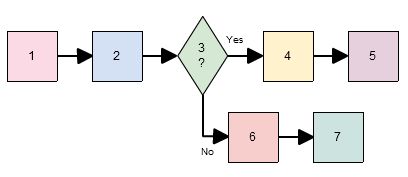SDoI: Chapter 3: Conducting a Goal Analysis

Goal Analysis Diagram by Elizabeth Lavolette is licensed
under a Creative Commons Attribution 3.0 United States License.
[This is the fourth in a series of posts about Dick and Carey’s The Systematic Design of Instruction. Want to read an overview and my thoughts on Chapter 1 and Chapter 2 before proceeding?]
Chapter 3 starts out strong, including this sentence on page 34:
This content approach stresses knowing, whereas the instructional design approach stresses doing.
Yes! That’s exactly what I want in an approach. If I am designing a language course, I don’t want students to know facts about the language; I want them to be able to, for example, communicate with people using the language. (Although knowing facts, such as the meaning of words, is clearly part of being able to communicate in a language!)
The middle of the chapter is showing its age. (I am reading the fourth edition, copyright 1996.) It’s all about making diagrams to represent goal analyses – without a single mention of computer tools to simplify this! I made the diagram above using Cacoo, a free web app that make it very simple to create such diagrams.
On page 39, I was surprised to read that
As a general rule, at this stage, you would typically have at least five steps but not more than fifteen for one to two hours of instruction.
I do not disagree with this statement, but I was surprised to see definite numbers suggested, even such a wide range. And of course, this is limited to the typical situation, so there are always exceptions.
Also on page 39, I had another surprise:
One special note should be made about the goal analysis of a verbal information goal. . . . In a sense, there is no intellectual or psychomotor procedure other than the presentation of a test question and the retrieval of the answer. . . . Therefore, the goal analysis indicates only the specific cues the learner might use to retrieve the desired information, but there is no sequence of steps per se.
From one point of view this is a relief to me: Those in the field of instructional design have not found some secret way to teach verbal information (such as foreign/second language vocabulary) that I have been unaware of all this time. On the other hand, if only they had!!! I am still hoping to find something earth-shattering in this book that I can bring to my design of language courses, but I will be happy with simply learning the Dick and Carey system.
A couple of further notes about the summary at the end of the chapter:
The goal analysis process is begun only after you have a clear statement of the instructional goal. The first step in the goal analysis is to classify the goal into one of the four domains of learning. It will be either an attitude, an intellectual skill, verbal information, or a psychomotor skill. (p. 46)
So, this implies that no goal can be a combination of different skills – or if it is, you have not stated the goal clearly enough. I’m going to keeping thinking on this point as I read the rest of the book, but my gut reaction is that this is an oversimplification. What about a seemingly straightforward goal like “Students will be able to introduce themselves in Japanese in a culturally appropriate manner”? I immediately see the necessity to learn words (or at the very least, set phrases) in Japanese, i.e., verbal information; grammar (at the very least to know where in the phrase to insert your name), i.e., an intellectual skill; and cultural norms of which phrases to use with which interlocutors – perhaps more verbal information, but requiring a certain attitude in order to be put to use.
Finally, I have a question about this statement on page 47:
When there is no natural chronology among the steps, however, they should be sequenced based on the inherent relationships among them, for example, spatial, easy to complex, familiar to unfamiliar, common content areas, and so forth.
Why? I don’t disagree with this statement – in fact, it seems quite natural to arrange things this way. But I’d be interested to see some research in this area. I seem to recall reading a study that found that participants had more trouble learning the meanings of foreign words when synonyms and antonyms were taught together than when they were taught in differently arranged groups, but I do not remember the details. Anyone out there have some insight?

